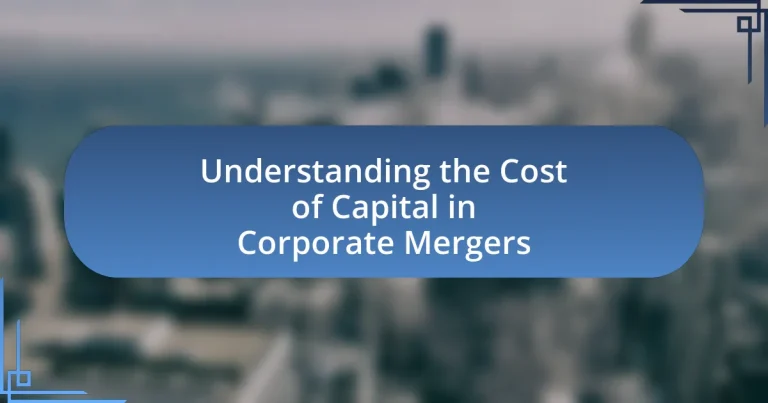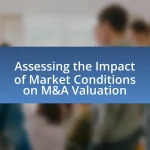The article focuses on the Cost of Capital in corporate mergers, which is the required return necessary for investors to find a merger or acquisition worthwhile. It explains how the Cost of Capital is calculated using the weighted average cost of capital (WACC), incorporating both equity and debt costs. Key components influencing the Cost of Capital, such as market conditions, risk profiles, and capital structures, are discussed, along with their impact on merger valuation and success rates. The article emphasizes the importance of accurately assessing the Cost of Capital to ensure informed decision-making and optimal financial outcomes in merger transactions.
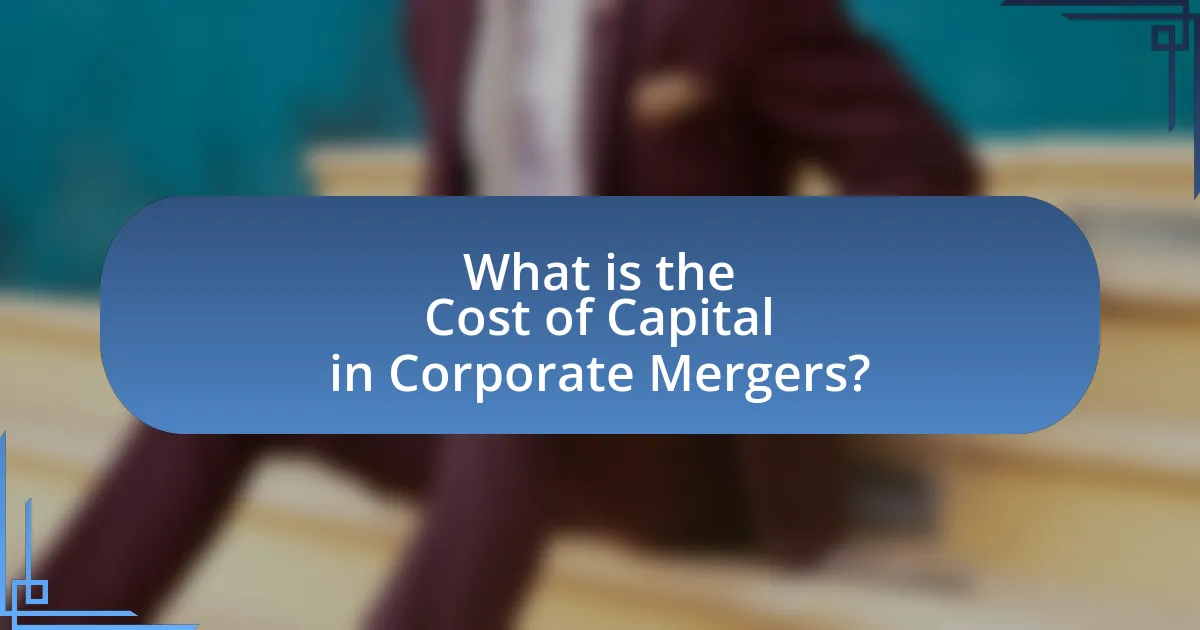
What is the Cost of Capital in Corporate Mergers?
The cost of capital in corporate mergers refers to the required return necessary to make a merger or acquisition worthwhile for investors. This cost is typically calculated using the weighted average cost of capital (WACC), which incorporates the cost of equity and the cost of debt, reflecting the risk associated with the merged entity. For instance, if a company has a WACC of 8%, this indicates that the company must generate at least an 8% return on its investments to satisfy its investors. The cost of capital is crucial in evaluating potential mergers, as it helps determine whether the expected returns from the merger exceed this threshold, thereby influencing the decision-making process.
How is the Cost of Capital defined in the context of mergers?
The Cost of Capital in the context of mergers is defined as the minimum return that a company must earn on its investment to satisfy its investors, which includes both equity and debt holders. This metric is crucial during mergers as it helps determine the feasibility and valuation of the merger by assessing whether the expected returns from the combined entity exceed this cost. For instance, if a merger is projected to generate returns greater than the calculated Cost of Capital, it indicates a potentially value-adding transaction for shareholders.
What are the key components that make up the Cost of Capital?
The key components that make up the Cost of Capital are the cost of equity, the cost of debt, and the weighted average cost of capital (WACC). The cost of equity represents the return required by equity investors, which can be estimated using models such as the Capital Asset Pricing Model (CAPM). The cost of debt is the effective rate that a company pays on its borrowed funds, typically calculated as the yield to maturity on existing debt. WACC combines these costs, weighted by the proportion of equity and debt in the company’s capital structure, providing a comprehensive measure of the overall cost of capital. This framework is essential for evaluating investment opportunities and making informed financial decisions in corporate mergers.
How does the Cost of Capital differ between various types of mergers?
The Cost of Capital varies significantly between different types of mergers, primarily due to differences in risk profiles and financing structures. In horizontal mergers, where companies in the same industry combine, the Cost of Capital may decrease due to increased market share and economies of scale, leading to lower perceived risk. Conversely, in vertical mergers, which involve companies at different stages of production, the Cost of Capital can be higher due to integration risks and potential operational inefficiencies.
Additionally, in conglomerate mergers, where firms from unrelated industries merge, the Cost of Capital often reflects a higher risk premium because of the lack of synergies and the challenges of managing diverse business operations. Research indicates that the average Cost of Capital for horizontal mergers can be around 8%, while vertical mergers may see rates closer to 10%, and conglomerate mergers can exceed 12%. These variations underscore the importance of assessing the specific merger type when evaluating the Cost of Capital.
Why is understanding the Cost of Capital crucial for corporate mergers?
Understanding the Cost of Capital is crucial for corporate mergers because it directly influences the valuation of the target company and the financial structure of the merged entity. The Cost of Capital represents the minimum return that investors expect for providing capital to the company, which is essential for assessing whether the merger will create value. Accurate estimation of the Cost of Capital allows companies to evaluate potential synergies, determine the appropriate financing mix, and make informed decisions regarding the merger’s feasibility. For instance, a study by Modigliani and Miller (1958) highlights that the Cost of Capital affects investment decisions and capital structure, emphasizing its importance in merger scenarios.
What role does the Cost of Capital play in merger valuation?
The Cost of Capital is a critical factor in merger valuation as it represents the minimum return that investors expect for providing capital to the merged entity. This metric influences the discount rate used in discounted cash flow analyses, which are essential for estimating the present value of future cash flows generated by the merger. A higher Cost of Capital typically results in a lower valuation, as future cash flows are discounted more heavily, reflecting increased risk or higher expected returns required by investors. For instance, if a company’s Cost of Capital is 10%, future cash flows will be discounted at this rate, directly impacting the perceived value of the merger. Thus, accurately determining the Cost of Capital is vital for achieving a realistic and fair valuation in merger transactions.
How can the Cost of Capital impact the success of a merger?
The Cost of Capital significantly impacts the success of a merger by influencing the financial viability and attractiveness of the deal. A lower Cost of Capital allows the acquiring company to finance the merger more affordably, enhancing potential returns on investment and increasing the likelihood of achieving synergies. Conversely, a higher Cost of Capital can deter investment, making the merger less appealing and potentially leading to underperformance post-merger. For instance, according to a study by KPMG, mergers with a favorable Cost of Capital have a 30% higher success rate in achieving projected synergies compared to those with a higher Cost of Capital. This demonstrates that the Cost of Capital is a critical factor in determining the overall success and sustainability of mergers.
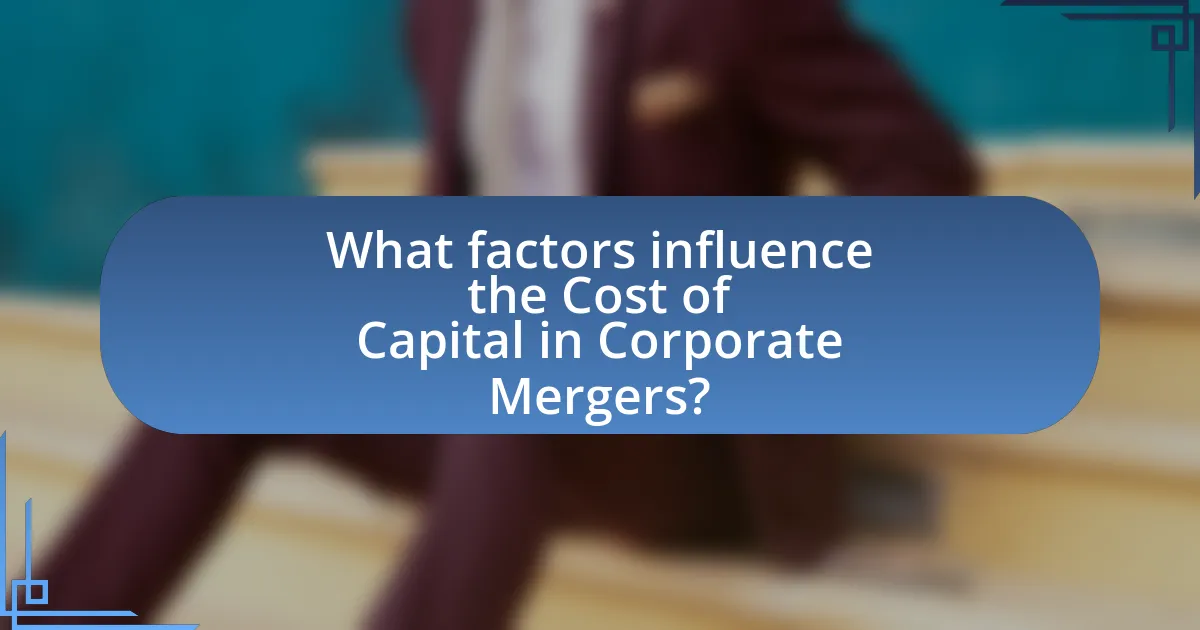
What factors influence the Cost of Capital in Corporate Mergers?
The cost of capital in corporate mergers is influenced by several key factors, including the risk profile of the merged entities, market conditions, and the capital structure of the companies involved. The risk profile is critical as it determines the expected return required by investors; higher perceived risks lead to a higher cost of capital. Market conditions, such as interest rates and investor sentiment, also play a significant role; for instance, rising interest rates typically increase the cost of debt, thereby raising the overall cost of capital. Additionally, the capital structure, which refers to the mix of debt and equity financing, affects the cost of capital; a higher proportion of debt can lower the cost of capital due to the tax deductibility of interest, but excessive debt increases financial risk, potentially raising the cost of equity. These factors collectively shape the financial landscape of corporate mergers, impacting the valuation and feasibility of such transactions.
How do market conditions affect the Cost of Capital?
Market conditions significantly influence the Cost of Capital by altering the risk perception and required returns of investors. When market conditions are favorable, such as low interest rates and high investor confidence, the Cost of Capital tends to decrease, making it cheaper for companies to finance projects. Conversely, during unfavorable market conditions, characterized by high interest rates or economic uncertainty, the Cost of Capital increases as investors demand higher returns to compensate for perceived risks. For instance, according to the Federal Reserve, a 1% increase in interest rates can raise the Cost of Capital by approximately 10% for firms reliant on debt financing. This relationship underscores the critical impact of market dynamics on corporate financing strategies, particularly in mergers and acquisitions.
What is the impact of interest rates on the Cost of Capital?
Interest rates directly influence the Cost of Capital by affecting the cost of debt financing. When interest rates rise, the cost of borrowing increases, leading to a higher Cost of Capital for companies that rely on debt. For instance, a study by the Federal Reserve indicates that a 1% increase in interest rates can raise the Cost of Capital by approximately 0.5% to 1% for firms with significant debt levels. Conversely, lower interest rates reduce borrowing costs, thereby decreasing the Cost of Capital, making it cheaper for companies to finance projects and investments. This relationship is crucial in corporate mergers, as a higher Cost of Capital can deter investment and affect merger valuations.
How does investor perception influence the Cost of Capital?
Investor perception significantly influences the Cost of Capital by affecting the risk assessment and required return on investment. When investors view a company positively, they are likely to accept a lower return, thereby reducing the Cost of Capital. Conversely, negative perceptions can lead to higher required returns, increasing the Cost of Capital. For example, a study by Baker and Wurgler (2006) in the Journal of Financial Economics found that investor sentiment can impact stock prices and, consequently, the cost of equity capital. This relationship highlights how perceptions directly correlate with financial metrics, demonstrating that favorable investor sentiment can lower financing costs for companies engaged in mergers.
What internal factors can affect a company’s Cost of Capital during a merger?
Internal factors that can affect a company’s Cost of Capital during a merger include the company’s existing capital structure, operational efficiency, and risk profile. The capital structure, which consists of the proportion of debt and equity financing, influences the overall cost of capital; a higher debt ratio may lower the cost due to tax advantages but increase financial risk. Operational efficiency, reflected in profit margins and cash flow stability, can enhance credit ratings, thereby reducing the cost of debt. Additionally, the risk profile, including business risk and market volatility, affects investor expectations and required returns, ultimately impacting the cost of equity. These factors collectively determine how a merger influences the overall Cost of Capital for the involved companies.
How do a company’s financial health and credit rating impact its Cost of Capital?
A company’s financial health and credit rating significantly influence its Cost of Capital by determining the risk perceived by investors and lenders. Strong financial health and a high credit rating typically lead to lower borrowing costs, as lenders view the company as a lower risk, resulting in lower interest rates on debt. For instance, companies with a credit rating of AAA can secure loans at rates significantly lower than those rated B or below, reflecting the risk premium associated with lower-rated entities. Consequently, a company with robust financial metrics, such as high profitability and low debt levels, can achieve a lower weighted average cost of capital (WACC), enhancing its ability to invest in growth opportunities and pursue mergers effectively.
What role does the capital structure play in determining the Cost of Capital?
The capital structure significantly influences the Cost of Capital by determining the proportion of debt and equity financing a company utilizes. A higher proportion of debt in the capital structure typically lowers the overall Cost of Capital due to the tax deductibility of interest payments, which reduces the effective cost of borrowing. Conversely, excessive debt increases financial risk, potentially raising the Cost of Capital as investors demand higher returns for increased risk. Empirical studies, such as those by Modigliani and Miller, demonstrate that the optimal capital structure minimizes the Cost of Capital, thereby enhancing firm value.
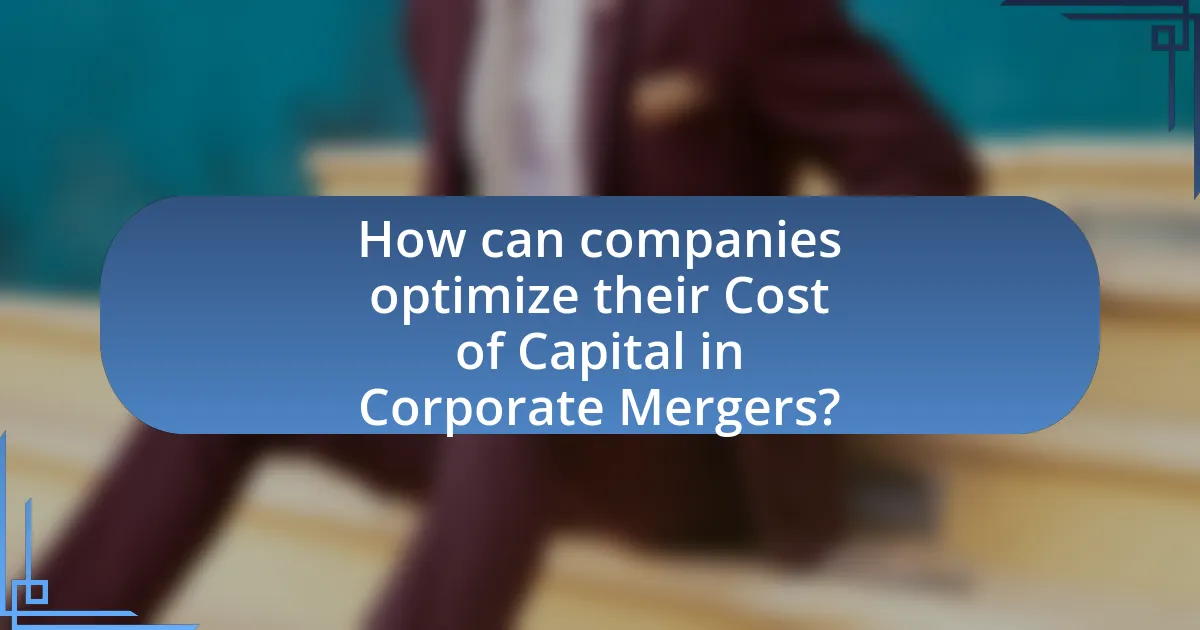
How can companies optimize their Cost of Capital in Corporate Mergers?
Companies can optimize their Cost of Capital in Corporate Mergers by strategically structuring the financing mix of debt and equity. A well-balanced capital structure minimizes the overall cost of capital, as debt typically has a lower cost than equity due to tax advantages and lower risk perceptions by lenders.
For instance, using debt financing can enhance returns on equity, as interest payments are tax-deductible, effectively lowering the company’s taxable income. According to Modigliani and Miller’s theorem, in a perfect market, the value of a firm is unaffected by its capital structure; however, in reality, optimal leverage can lead to a lower weighted average cost of capital (WACC).
Additionally, companies can conduct thorough due diligence to assess the target’s risk profile and integrate risk management strategies that align with the merged entity’s objectives. This approach can lead to a more favorable credit rating, further reducing borrowing costs. Historical data shows that firms that maintain a balanced capital structure during mergers often experience improved financial performance and shareholder value post-merger.
What strategies can be employed to lower the Cost of Capital?
To lower the Cost of Capital, companies can employ strategies such as optimizing their capital structure, improving credit ratings, and utilizing tax advantages. Optimizing capital structure involves balancing debt and equity to minimize the weighted average cost of capital (WACC); for instance, a higher proportion of low-cost debt can reduce overall costs. Improving credit ratings through consistent financial performance and effective risk management can lead to lower interest rates on borrowed funds. Additionally, utilizing tax advantages, such as interest tax shields from debt financing, can further decrease the effective cost of capital. These strategies are supported by financial theories indicating that a well-structured capital mix and favorable credit conditions directly influence the cost of capital.
How can companies improve their credit ratings before a merger?
Companies can improve their credit ratings before a merger by reducing their debt levels and enhancing their cash flow. Lowering debt decreases financial risk, which is a key factor in credit ratings. For instance, companies can pay down existing loans or refinance to secure better terms, thereby improving their debt-to-equity ratio. Additionally, increasing cash flow through operational efficiencies or revenue growth strengthens the company’s financial position, making it more attractive to credit rating agencies. Historical data shows that companies with lower leverage and stronger cash flows typically receive higher credit ratings, which can facilitate more favorable financing conditions during a merger.
What financing options are available to minimize the Cost of Capital?
To minimize the Cost of Capital, companies can utilize several financing options, including debt financing, equity financing, and hybrid instruments. Debt financing, such as issuing bonds or taking loans, typically has lower costs due to tax deductibility of interest payments, which can effectively reduce the overall cost of capital. Equity financing, while generally more expensive, can be optimized by issuing shares at favorable market conditions or through retained earnings, which do not incur additional costs. Hybrid instruments, like convertible bonds, offer flexibility and can attract investors seeking both fixed income and equity upside, potentially lowering the overall cost. Historical data shows that companies with a balanced capital structure, combining these financing options, often achieve a lower weighted average cost of capital (WACC), enhancing their financial performance in mergers.
What best practices should companies follow regarding the Cost of Capital in mergers?
Companies should conduct thorough due diligence to accurately assess the Cost of Capital during mergers. This involves evaluating the weighted average cost of capital (WACC) for both entities involved, which includes analyzing the cost of equity and the cost of debt. Accurate assessment is crucial because it influences the valuation of the merger and the expected returns on investment.
Additionally, companies should consider market conditions and industry benchmarks when determining their Cost of Capital, as these factors can significantly impact financing decisions. For instance, a study by Damodaran (2021) highlights that understanding the risk profile of the merged entity can lead to more informed capital structure decisions.
Finally, companies should regularly update their Cost of Capital calculations to reflect changes in market conditions and company performance, ensuring that they remain aligned with current economic realities. This practice helps in making strategic decisions that optimize financial outcomes post-merger.
How can thorough due diligence help in understanding the Cost of Capital?
Thorough due diligence aids in understanding the Cost of Capital by providing a comprehensive analysis of a company’s financial health, risk profile, and market conditions. This process involves evaluating financial statements, assessing operational efficiencies, and identifying potential liabilities, which collectively inform the risk factors associated with the investment. For instance, a detailed examination of a company’s debt levels and equity structure reveals the weighted average cost of capital (WACC), a critical metric for assessing investment viability. Additionally, due diligence uncovers industry benchmarks and historical performance data, allowing for a more accurate estimation of expected returns. By integrating these insights, stakeholders can make informed decisions regarding capital allocation and investment strategies, ultimately leading to a clearer understanding of the Cost of Capital in the context of corporate mergers.
What role does financial modeling play in assessing the Cost of Capital?
Financial modeling plays a critical role in assessing the Cost of Capital by providing a structured framework to evaluate the various components that influence capital costs. Through financial models, analysts can project future cash flows, determine the appropriate discount rates, and analyze the risk associated with different financing options. For instance, models such as the Weighted Average Cost of Capital (WACC) incorporate the cost of equity and debt, allowing for a comprehensive assessment of the overall capital cost. This approach is validated by empirical studies, which demonstrate that accurate financial modeling leads to more informed investment decisions and better alignment with market expectations.
What common pitfalls should companies avoid related to the Cost of Capital in mergers?
Companies should avoid underestimating the Cost of Capital when evaluating mergers, as this can lead to overvaluation of the target company. Accurate assessment of the Cost of Capital is crucial because it influences investment decisions and expected returns. For instance, a study by Damodaran (2021) highlights that miscalculating the Cost of Capital can result in a failure to achieve desired synergies, ultimately affecting the merger’s success. Additionally, companies should not ignore the impact of market conditions on their Cost of Capital, as fluctuations can significantly alter financing costs and risk assessments.
How can miscalculating the Cost of Capital lead to merger failures?
Miscalculating the Cost of Capital can lead to merger failures by causing companies to overestimate or underestimate the value of the merger, resulting in poor investment decisions. When the Cost of Capital is inaccurately assessed, it affects the discount rate used in valuation models, leading to incorrect projections of future cash flows and ultimately skewing the perceived financial viability of the merger. For instance, if a company underestimates its Cost of Capital, it may proceed with a merger that appears profitable but is actually not sustainable, as seen in the failed merger between AOL and Time Warner in 2000, where misjudged valuations contributed to significant financial losses.
What are the risks of ignoring market conditions when assessing the Cost of Capital?
Ignoring market conditions when assessing the Cost of Capital can lead to significant financial risks, including mispricing of investment opportunities and inadequate capital allocation. When market conditions are overlooked, companies may underestimate or overestimate their required return on investment, resulting in poor decision-making. For instance, during periods of high interest rates, failing to adjust the Cost of Capital accordingly can lead to accepting projects that do not meet the necessary return thresholds, ultimately harming profitability. Additionally, ignoring market volatility can expose firms to increased risk premiums, which may not be reflected in their cost assessments, leading to a misalignment between expected and actual returns. Historical data shows that companies that fail to account for market conditions often experience lower stock performance and higher capital costs, as evidenced by studies indicating that firms with a more accurate assessment of market dynamics achieve better financial outcomes.
